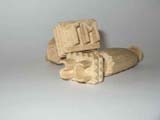

MATERA BREAD
The
history of the bread's making is closely linked to the agro-pastoral
culture of Matera e its surrounding areas and according to the meanings
and uses given to it, significant information about the way of living,
of thinking and the behaviour of the old society can be drawn.
The stamp for bread was necessary to mark the famous "Matera bread",
which since the Bourbon period, was made using just the durham wheat
flour giving a characteristic colour, flavour, and smell, unlike the
most of the other kinds of South Italian Bread. The bread, made only
of wheat, water, salt and yeast, was kneaded by women to obtain, in
particular for numerous families, up to 7-8 loaves of 5-6 kg each per
week. The habit of making home-made bread came mostly from the idea
that buying bread was a symbol of poverty; for this reason both the
English rich families and the poorest ones kneaded at home and then
for a fee, they cooked it in public wood-burning ovens scattered in
the Sassi. Bakers gave a shape to the leavened dough, then they marked
it with the stamp of each family and baked it to obtain the characteristic
"skuaneta" (the traditional loaf of Matera).
STAMPS FOR BREAD
Each family had got her own stamp to mark the leavened dough before
baking it. The stamps, made of wood, were kept in the public ovens or
carried by women at every baking.
The history of the stamps for bread has its origins in an indefinite
past and ends in the 1950s when the inhabitants of Matera, after the
building of new quarters and the use of the most modern electric ovens,
left the Sassi and gave up their tradition to make bread at home and
to cook it in public wood-burning ovens of the old districts.
The stamps were divided in three parts: the base (with relief letters)
to mark the leavened dough, the central section, having a vertical shape,
that served as a handle on which the ornament was carved and the top
(not very often present) composed of decorative elements which complete
the ornament of the handle.
The stamps for bread are the result of the agropastoral culture; they
were realised mostly by shepherds and farmers "on their own".
The shepherds carved wood in particular during the pasturing when the
feeling of solitude, due to the distance from home, allowed their own
emotions and thoughts to be free, so that they created stamps, bunches
of flax, and other objects.
Even the farmers and peasants created stamps for bread but, unlike the
shepherds, their creations were more less decorated and were simply
practical..
In the agropastoral culture the stamp for bread and the stamping of
the leavened dough also had ritual and magical meanings associated to
intercourses and insemination, to the concept of life, strength, power,
fertility, and so on. For this reason the stamp on the leavened dough
was done not only in the public ovens to distinguish the possession
but also in the one-family ones where this necessity did not exist;
but in this last case, instead of carving the initials of the householder,
characteristic signs and symbols referring to the Sun were engraved
( circumferences with continuous or dotted strokes, stars, crosses).
It is clear that the stamp and the process of the leavened dough stamping
referred to a much more complex ritual and behavioural dimension, with
a magic-sexual content and reference, which evoked the action of repeated
insemination as a propitiatory value and directed to protect the dough,
symbolically, through the transfer, by contact, of the characteristics
and qualities given to the sign, during the phases of its transformation
in the oven.
The subjects represented on the stamps belong to four categories: human,
animal, phallic symbols and symbols derived from architecture. Apart
from this classification, the most common symbols almost always refer
to the concept of fecundation , abundance and prosperity associated
to some particular feminine features (the breast and the belly), to
the whole human aspect or to the representation of specific animals
( as the hen) being able " to procreate" as men do. We can
also add other symbols referring to the strength, virility, order imposed
from the top characteristic of the stamps which represents carabinieres,
soldiers, men and cocks, symbols of fertility and defence as phallic
representations or animals like dogs and birds or moreover stamps with
a spiritual and religious significance different from the typical Christian
iconic elements ( Christ monogram, the Cross, the Sacred Heart ).
In addition to this functional and symbolic value, the stamp for bread
also had a social meaning ; for example farmers and peasants offered
it to their master's wife as a sign of respect; it represented one of
the way through which the householder reminded to his family, by means
of the bread stamped with his initials, his authority and superiority
or it was offered by a man to his loved woman and used, in case of acceptance,
as a positive answer to a marriage proposal.
Between the two wars, the craftsmen started to produce iron stamps completely
linear, lacking of symbolic or decorative elements, having a long handle
(15-30 cm) and a disc-shaped base with the only initials of the householder;
the production of the stamps for bread finished, as we told before,
after the great moving of the inhabitants of Matera from the Sassi to
the new quarters around 1950s.
© Copyright
2005 Antonio Cosola
Vietata la riproduzione anche parziale dei contenuti di questo sito
senza la preventiva autorizzazione scritta dell'autore. Tutti i diritti
sono riservati.
Sito realizzato da
Sandro Cosola